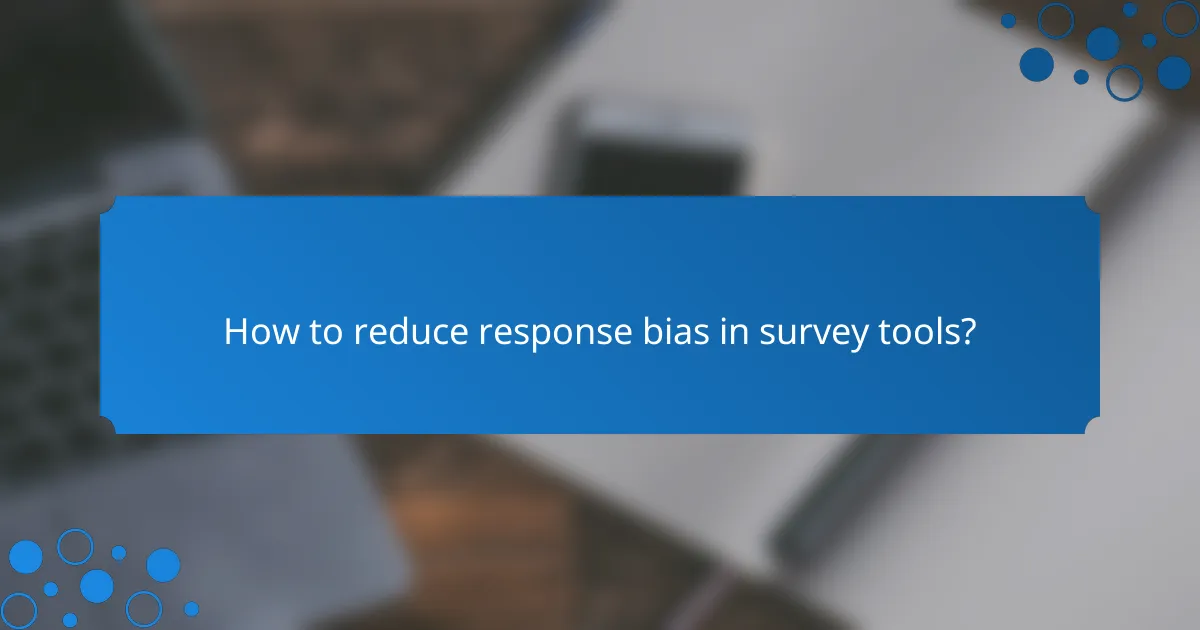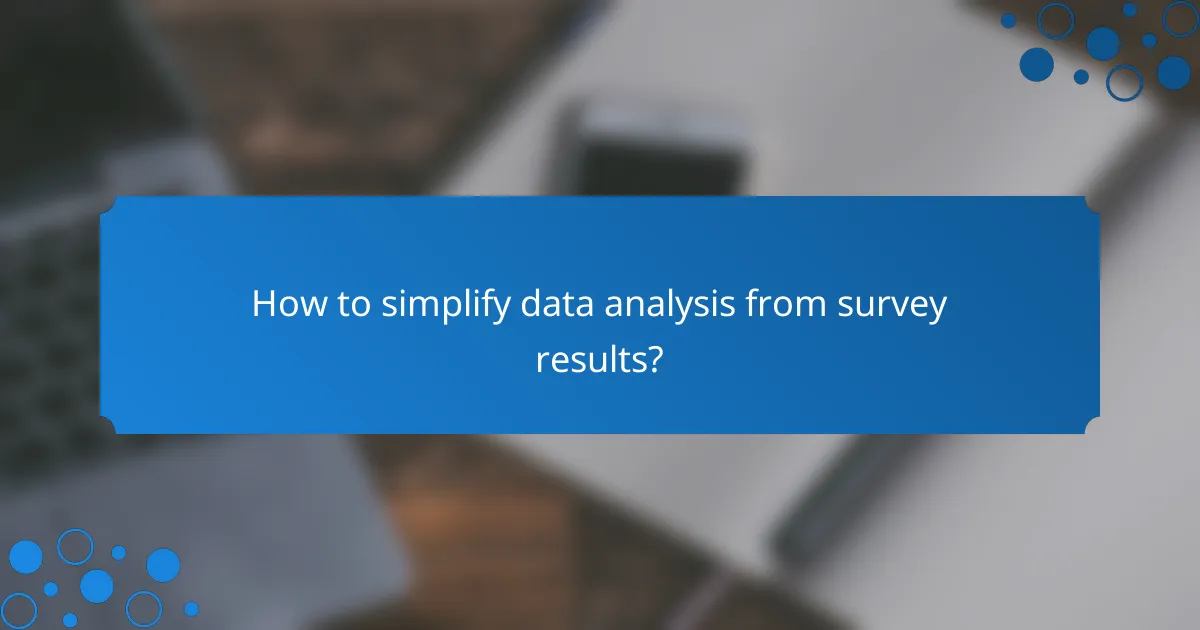Survey tools are essential for gathering insights, yet they often face challenges such as response bias, low participation rates, and complex data analysis. To enhance the reliability of survey results, it’s crucial to implement strategies that encourage honest feedback and engage respondents effectively. Additionally, leveraging automated solutions can simplify data analysis, allowing for quicker and more meaningful insights.

How to reduce response bias in survey tools?
To reduce response bias in survey tools, implement strategies that encourage honest and accurate feedback from participants. This can be achieved through techniques like randomization, anonymity, neutral wording, and mixed methods.
Use randomized response techniques
Randomized response techniques allow respondents to answer sensitive questions while maintaining their privacy. By introducing a random element, such as a coin flip, participants can respond truthfully without fear of judgment. This method can significantly improve the reliability of data collected on sensitive topics.
For example, if a survey asks about illegal activities, a randomized response could allow participants to answer truthfully without directly linking their response to their identity. This approach can lead to more accurate data, particularly in surveys addressing stigmatized behaviors.
Implement anonymous surveys
Anonymous surveys help reduce response bias by ensuring that participants feel safe sharing their true opinions. When respondents know their identities are protected, they are more likely to provide honest feedback. This is particularly important in sensitive areas like employee satisfaction or health-related topics.
To implement anonymity effectively, avoid collecting identifiable information and use secure platforms that guarantee data protection. Clearly communicate the anonymity of the survey to encourage participation and honest responses.
Design neutral question wording
Neutral question wording is crucial in minimizing response bias. Leading or loaded questions can skew results by influencing how respondents interpret and answer them. Aim for clarity and neutrality to ensure that questions do not suggest a preferred response.
For instance, instead of asking, “How much do you enjoy our excellent service?” rephrase to “How would you rate your experience with our service?” This subtle change allows respondents to provide a more accurate reflection of their views without bias from the question’s phrasing.
Utilize mixed-method approaches
Mixed-method approaches combine quantitative and qualitative data collection, providing a more comprehensive understanding of survey topics. By using both closed-ended questions for statistical analysis and open-ended questions for deeper insights, you can capture a fuller picture of participant perspectives.
For example, following a quantitative survey with open-ended questions allows respondents to elaborate on their ratings. This combination can help identify underlying reasons for certain responses, reducing bias by providing context to the numbers.

What strategies can increase participation rates in Australia?
To boost participation rates in Australia, implement strategies that engage respondents and make the survey experience rewarding. Effective methods include offering incentives, optimizing survey design, targeting specific demographics, and leveraging social media for outreach.
Offer incentives for completion
Providing incentives can significantly enhance survey participation rates. Consider offering gift cards, discounts, or entry into a prize draw as rewards for completing the survey. These incentives can motivate respondents to take the time to engage with your survey.
When choosing incentives, ensure they are appealing to your target audience. For instance, if your survey targets students, consider offering vouchers for popular retailers or local cafes. This approach can lead to higher response rates and more reliable data.
Optimize survey length and design
A well-structured survey that is concise and visually appealing can lead to increased participation. Aim for a completion time of under 10 minutes to maintain respondent interest. Use clear language and avoid jargon to ensure that questions are easily understood.
Incorporate a mix of question types, such as multiple-choice and rating scales, to keep the survey engaging. Additionally, ensure that the survey is mobile-friendly, as many respondents may prefer to complete it on their smartphones.
Target specific demographics effectively
Identifying and targeting specific demographics can enhance participation rates. Use demographic data to tailor your outreach efforts, ensuring that your survey reaches the right audience. For example, if your survey focuses on health-related topics, target individuals within specific age groups or health conditions.
Consider using segmentation strategies to create personalized invitations for different demographic groups. This can include customizing the language and tone of your survey invitations to resonate with each group, thereby increasing the likelihood of participation.
Leverage social media for outreach
Social media platforms can be powerful tools for increasing survey participation. Share your survey on platforms like Facebook, Instagram, and LinkedIn to reach a broader audience. Engaging posts that highlight the importance of the survey can encourage users to participate.
Utilize targeted ads on social media to reach specific demographics based on interests, location, and behaviors. This approach can help you connect with potential respondents who are more likely to engage with your survey, ultimately improving participation rates.

How to simplify data analysis from survey results?
Simplifying data analysis from survey results involves leveraging tools and techniques that streamline the process, making it more efficient and insightful. By utilizing automated solutions and visualization platforms, you can quickly derive meaningful insights from your data.
Use automated data analysis tools
Automated data analysis tools can significantly reduce the time and effort required to process survey results. These tools often use algorithms to identify trends, patterns, and anomalies in the data, allowing for quicker decision-making.
Popular options include Google Forms, SurveyMonkey, and Qualtrics, which offer built-in analytics features. When selecting a tool, consider its ease of use, integration capabilities, and the specific analytics features that meet your needs.
Visualize data with platforms like Tableau
Data visualization platforms like Tableau help transform raw survey data into interactive and comprehensible visual formats. By creating charts, graphs, and dashboards, you can present complex data in a way that is easier for stakeholders to understand.
Effective visualizations can highlight key findings and trends, making it easier to communicate insights. Aim to use clear labels and avoid clutter to ensure your visualizations are impactful.
Employ statistical software like SPSS
Statistical software such as SPSS provides advanced analytical capabilities for in-depth data analysis. This software allows you to perform complex statistical tests, regression analyses, and predictive modeling, which can uncover deeper insights from your survey data.
While SPSS is powerful, it may require a learning curve. Consider investing time in training or tutorials to maximize its potential for your specific analysis needs.
Integrate with CRM systems for insights
Integrating survey data with Customer Relationship Management (CRM) systems can enhance your understanding of customer behavior and preferences. By linking survey responses to customer profiles, you can gain insights that drive targeted marketing and service improvements.
Ensure that your CRM system supports data integration and consider using APIs or middleware solutions to facilitate this process. This integration can lead to more personalized customer interactions and improved satisfaction rates.

What are the common types of response bias?
Response bias refers to systematic errors in survey responses that can skew data and lead to inaccurate conclusions. Understanding the common types of response bias is crucial for designing effective surveys and interpreting results accurately.
Social desirability bias
Social desirability bias occurs when respondents provide answers they believe are more socially acceptable rather than their true feelings or behaviors. This bias can lead to inflated reports of positive behaviors or attitudes, such as charitable giving or healthy habits.
To mitigate social desirability bias, consider using anonymous surveys or indirect questioning techniques. For example, instead of asking directly about sensitive topics, you might ask respondents to report on the behaviors of a hypothetical peer group.
Acquiescence bias
Acquiescence bias, also known as “yea-saying,” happens when respondents tend to agree with statements regardless of their actual opinions. This can distort survey results, especially in scales where agreement is measured.
To reduce acquiescence bias, use balanced scales that include both positive and negative statements. Additionally, varying the wording of questions can help ensure that respondents are thoughtfully considering their answers rather than defaulting to agreement.
Nonresponse bias
Nonresponse bias occurs when certain groups of people do not respond to a survey, leading to skewed results. This can happen if the survey is too long, not engaging, or if it targets a demographic that is less likely to participate.
To minimize nonresponse bias, keep surveys concise and relevant, and consider offering incentives for participation. Additionally, follow up with non-respondents to encourage their input, which can help balance the data collected.

What frameworks help in selecting survey tools?
Choosing the right survey tools involves evaluating various frameworks that address user-friendliness, integration capabilities, and pricing models. These factors significantly influence the effectiveness of data collection and analysis, ensuring that the selected tool meets your specific needs.
Evaluate user-friendliness
User-friendliness is critical when selecting survey tools, as it directly impacts response rates and data quality. Look for intuitive interfaces that allow both creators and respondents to navigate easily. Tools with drag-and-drop features or customizable templates can enhance the experience.
Consider conducting a trial run with potential tools to assess their usability. A good heuristic is to ensure that the tool requires minimal training for users, ideally allowing new users to create and distribute surveys within a few minutes.
Assess integration capabilities
Integration capabilities determine how well survey tools work with existing systems, such as CRM software or data analysis platforms. Tools that offer seamless integration can streamline data collection and reduce manual entry errors, enhancing overall efficiency.
Check if the survey tool supports APIs or has pre-built connectors for popular applications. This can save time and effort, especially if you plan to analyze data in software like Excel or Google Sheets. Aim for tools that can integrate with at least a few key platforms you currently use.
Consider pricing models
Pricing models vary widely among survey tools, so it’s essential to understand the costs involved. Some tools offer free tiers with limited features, while others may charge monthly or annual fees based on usage or the number of respondents.
Evaluate your budget and the scale of your survey needs. For instance, if you anticipate high participation rates, consider tools that offer bulk pricing or unlimited responses. Always compare features against costs to ensure you’re getting the best value for your investment.

What are advanced techniques for survey data analysis?
Advanced techniques for survey data analysis include methods that enhance the reliability and depth of insights drawn from survey responses. These techniques help address common issues like response bias, low participation rates, and the complexity of data interpretation.
Addressing response bias
Response bias occurs when participants provide inaccurate answers, often influenced by social desirability or question framing. To mitigate this, researchers can employ techniques such as randomized response models or indirect questioning, which encourage honesty by allowing respondents to answer sensitive questions more freely.
Another effective method is to use mixed-mode surveys, combining online and offline approaches to reach diverse demographics. This can help balance out biases that may arise from a single mode of data collection.
Improving participation rates
Low participation rates can skew survey results and limit the generalizability of findings. To enhance participation, consider offering incentives, such as gift cards or entry into a prize draw, which can motivate respondents to engage with the survey.
Additionally, optimizing survey design for mobile devices and keeping surveys concise can significantly improve response rates. Aim for a completion time of under 10 minutes to maintain participant interest and reduce drop-off rates.
Simplifying data analysis
Data analysis complexity can be reduced by using software tools that automate data cleaning and provide user-friendly interfaces for statistical analysis. Tools like SPSS or R can help streamline the process, allowing for easier interpretation of results.
Employing visual data representation techniques, such as charts and graphs, can also aid in understanding trends and patterns. Aim to summarize findings in clear visuals that highlight key insights without overwhelming the audience with excessive detail.
